| Article ID | Journal | Published Year | Pages | File Type |
|---|---|---|---|---|
| 67327 | Journal of Molecular Catalysis A: Chemical | 2009 | 6 Pages |
Ruthenium(III) complex catalyzed oxidation of aliphatic amines with bromamine-T under alkaline condition proceeds efficiently to afford carboxylic acids in high conversion. Hexa-coordinated ruthenium(III) complex of the type [RuCl2(PPh3)(L)] (L, tridentate ligand derived by the condensation of o-phenylene diamine with salicylaldehyde) has been synthesized and it was used as a catalyst for the oxidative conversion of amines to carboxylic acids. The detailed mechanistic and kinetic investigations have been made for the oxidation reactions. Under similar experimental conditions all the amines proceed with a common oxidation mechanism and follows an identical kinetics with first-order dependence each on [Oxidant]o and [Amine]o, and fractional order with respect to [Catalyst] and [OH−]. To understand the detailed kinetics and mechanism of the reactions, the reactions have been subjected to changes in (i) dielectric permittivity, (ii) primary salt effect, (iii) halide ions and (v) temperature. The reactions were carried out at different temperature and the activation parameters have been calculated. From enthalpy–entropy relationships and Exner correlations, the isokinetic temperature (β) of 382 K, calculated is much higher than the experimental temperature (313 K), indicating that, the enthalpy factor controls the rate. The observed results have been explained by a plausible mechanism and the related rate law has been deduced. The present method developed for the oxidation of amines to carboxylic acids by bromamine-T offers several advantages including high conversion, short reaction times, and stable, cost effective and relatively non-toxic reagents which make the reaction process simple and smooth.
Graphical abstractRuthenium(III) complex catalyzed oxidation of aliphatic amines with bromamine-T under alkaline condition was performed efficiently to afford carboxylic acids in high conversion. The detailed kinetic and mechanistic investigations have been made. The related rate law has been deduced. Mechanism of amine oxidation is as shown in the following scheme.Figure optionsDownload full-size imageDownload as PowerPoint slide
